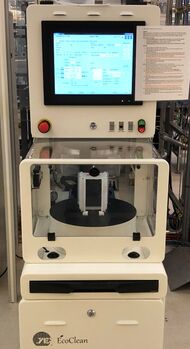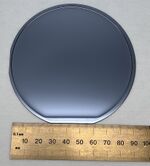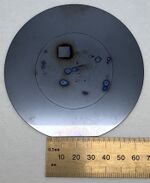Plasma Clean (YES EcoClean): Difference between revisions
(added etch method & applications) |
(SOP Rev) |
||
| (5 intermediate revisions by 3 users not shown) | |||
| Line 1: | Line 1: | ||
{{ |
{{tool2|{{PAGENAME}} |
||
|picture= IMG_5385.JPG |
|picture= IMG_5385.JPG |
||
|type = Dry Etch |
|type = Dry Etch |
||
|super= Lee Sawyer |
|super= Lee Sawyer |
||
|super2= Aidan Hopkins |
|||
|location=Bay 5 |
|location=Bay 5 |
||
|description = EcoClean Asher |
|description = EcoClean Asher |
||
| Line 16: | Line 17: | ||
Samples can be heated from ~120°C to 200°C by controlling the sample height via the lift pins during process, while being exposed to ICP-cracked oxygen to remove organic materials. |
Samples can be heated from ~120°C to 200°C by controlling the sample height via the lift pins during process, while being exposed to ICP-cracked oxygen to remove organic materials. |
||
=== |
===Etch Method=== |
||
The excitation of the oxygen is done remotely and a baffle keeps charged ions from reaching the surface, leaving primarily neutral Oxygen radicals in the gas mixture. Radicals diffuse and are scattered across the wafer surface for efficient cleaning and PR removal without any ion damage. This behaves like a wet-etch with reactive Oxygen. No ion bombardment at all, so isotropic (omni-directional) etch - attacks sidewalls just as fast as top surfaces. Heat is used to increase reaction rate. Treat this as a purely chemical process, accelerated by heat (Arrhenius plot - rate goes up exponentially with temperature). |
The excitation of the oxygen is done remotely and a baffle keeps charged ions from reaching the surface, leaving primarily neutral Oxygen radicals in the gas mixture. Radicals diffuse and are scattered across the wafer surface for efficient cleaning and PR removal without any ion damage. This behaves like a wet-etch with reactive Oxygen. No ion bombardment at all, so isotropic (omni-directional) etch - attacks sidewalls just as fast as top surfaces. Heat is used to increase reaction rate. Treat this as a purely chemical process, accelerated by heat (Arrhenius plot - rate goes up exponentially with temperature). |
||
Note that our recipes use a lift-pin to adjust temperature quickly, with hotplate always set to 200°C (constant). This means that the ''back'' of the wafer is exposed to the reactive gas for temperatures <200°C (when wafer is lifted). |
|||
| ⚫ | |||
| ⚫ | |||
Resist etch rates of multiple microns per minute can be achieved. |
Resist etch rates of multiple microns per minute can be achieved. |
||
| Line 25: | Line 28: | ||
See the process pages below for etch recipes for various resist removal recipes. |
See the process pages below for etch recipes for various resist removal recipes. |
||
===Detailed Info=== |
|||
The following carrier wafers are available, with depressed etched pockets to prevent samples from sliding of the carrier. |
|||
{| class="wikitable" |
|||
|[[File:YES Pocket Carrier Wafers - 90mm pocket.jpg|alt=YES Ecoclean carrier wafer - Image of etched silicon wafer with raised edge.|none|thumb|166x166px|~90mm carrier wafer with raised edge.]] |
|||
|[[File:YES Pocket Carrier Wafers - 50mm pocket.jpg|alt=YES Ecoclean carrier wafer - Image of etched silicon wafer with raised edge and 50mm pocket.|none|thumb|183x183px|50mm carrier wafer]] |
|||
|} |
|||
Please the '''''Recipes''''' page linked below for important info on preventing oxidation of certain metals, and which recipes to run to prevent that. |
|||
==Documentation== |
==Documentation== |
||
*[https://wiki. |
*[https://wiki.nanofab.ucsb.edu/w/images/e/ed/YES_SOP_Rev_F.pdf YES Plasma Strip System Standard Operating Procedure] |
||
*[https://www.yieldengineering.com/Products/Plasma-Strip-Descum-Systems/YES-%C3%89coClean YES EcoClean Manufacturer Page] |
*[https://www.yieldengineering.com/Products/Plasma-Strip-Descum-Systems/YES-%C3%89coClean YES EcoClean Manufacturer Page] |
||
== |
==Recipes== |
||
Recipes > Dry Etching > Oxygen Plasma > [[Oxygen Plasma System Recipes#Plasma Clean .28YES EcoClean.29|'''<u>YES Ecoclean Recipes</u>''']] |
Recipes > Dry Etching > Oxygen Plasma > [[Oxygen Plasma System Recipes#Plasma Clean .28YES EcoClean.29|'''<u>YES Ecoclean Recipes</u>''']] |
||
*''Note this page lists important process info regarding the availableO2, N2/O2 recipes and oxidation of certain metals.'' |
|||
Latest revision as of 15:54, 28 May 2024
| ||||||||||||||||||||||||||
About
The YES EcoClean system is an ICP downstream asher used for the removal of resist and other organics.
4" wafers are cassette loaded or smaller samples are loaded onto 4" carriers into the system.
Samples can be heated from ~120°C to 200°C by controlling the sample height via the lift pins during process, while being exposed to ICP-cracked oxygen to remove organic materials.
Etch Method
The excitation of the oxygen is done remotely and a baffle keeps charged ions from reaching the surface, leaving primarily neutral Oxygen radicals in the gas mixture. Radicals diffuse and are scattered across the wafer surface for efficient cleaning and PR removal without any ion damage. This behaves like a wet-etch with reactive Oxygen. No ion bombardment at all, so isotropic (omni-directional) etch - attacks sidewalls just as fast as top surfaces. Heat is used to increase reaction rate. Treat this as a purely chemical process, accelerated by heat (Arrhenius plot - rate goes up exponentially with temperature).
Note that our recipes use a lift-pin to adjust temperature quickly, with hotplate always set to 200°C (constant). This means that the back of the wafer is exposed to the reactive gas for temperatures <200°C (when wafer is lifted).
Applications
Resist etch rates of multiple microns per minute can be achieved.
Use this where you know a purely chemical etch will suffice, for example PR etching. PR stripping is fast and cassette loaded. Works best for PR that hasn't been significantly changed (eg. Chlorinated, or Polymerized - in these cases some small residue can be left.) - follow up with PEii Technics etch to remove more stubborn residues.
See the process pages below for etch recipes for various resist removal recipes.
Detailed Info
The following carrier wafers are available, with depressed etched pockets to prevent samples from sliding of the carrier.
Please the Recipes page linked below for important info on preventing oxidation of certain metals, and which recipes to run to prevent that.
Documentation
Recipes
Recipes > Dry Etching > Oxygen Plasma > YES Ecoclean Recipes
- Note this page lists important process info regarding the availableO2, N2/O2 recipes and oxidation of certain metals.


